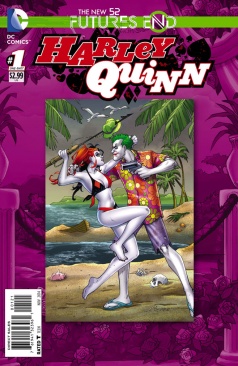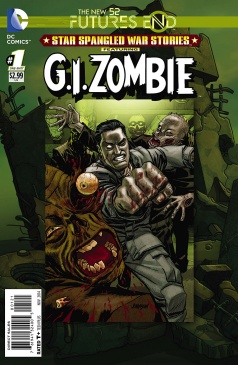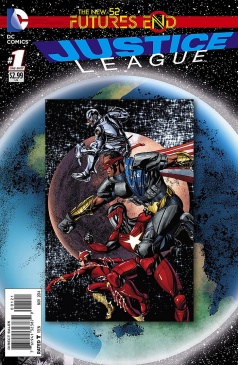
For the second year in a row, DC found gold in special edition lenticular covers, leading the comic industry’s publisher sales charts by a healthy margin thanks to its “Futures End” month after spending much of the year falling further and further back behind Marvel in second place. These lenticular covers – 3D covers with a fancy name – were first utilized by DC in September 2013’s “Villains Month” endeavor, a month in which each of its titles were taken over by some of the primary villains in their universe, and that time they saw even more considerable gains from them, outdistancing Marvel by nearly 16% in terms of units sold.
At the time of that first foray into a month built around fancy covers and secondary creative teams (the usual creative teams weren’t used on the books almost across the board), many retailers were outspoken for how Villains Month was handled. Brian Hibbs wrote at CBR about how he viewed the entire endeavor, opining that he “sell(s) stories for a living, not covers.” Many others said the same, and shared the frustrations they had in acquiring enough inventory of the 3D covers to fulfill the desires of their customers. In many minds, DC had committed an injustice on its customers, the retailing public.
At least at first.
You see, in the hoopla of the inventories being low for these covers, the speculator market was built up and so was the excitement about it amongst many average readers, leading most retailers to achieve great success in selling these titles (despite the low quality of the content and weaker creative teams). It worked for DC. It worked for retailers. Some readers were happy, especially the ones who resold Joker’s Daughter for a mint.
Naturally – as I predicted once sales numbers hit last year – this led to the aforementioned Futures End month this September, with DC ready this time. They wouldn’t be caught with their pants down again, and that meant making sure there would be ample inventory for retailers and customers alike. Fast forward to this past Friday, and the truth was revealed: 3D covers sure do sell well.
Here’s the only problem, though: they don’t really. At least not this time, and not to actual comic readers. What Multiversity has found is an endeavor that catapulted one publisher to the top of the charts, and a whole lot of retailers left with unsold inventory, as it was a bomb with readers in a way only Futures End’s Plastique might be able to appreciate.
Sell-Through, Not Sales
Before we start, here’s a quick aside for those who are less familiar with the way comic sales work. When comic sales are reported from Diamond Comic Distributors, those sales aren’t sales in a traditional sense. Those are sales from publishers through Diamond to the direct market, aka comic shops. Those are the total orders by every retailer that purchases through Diamond. Those numbers do not actually reflect sales in the traditional sense, and by that I mean sales from retailers to customers like you or me. Sell-through numbers are not tracked on a broad scale, only typically on a store-by-store basis.
The Retail Reality
When it comes to a big event like Futures End month and its cavalcade of sparkly covers, a comic retailer’s job is incredibly difficult. In a usual month their job is tough, as they have to order their inventory three months in advance with only one opportunity to adjust those orders on final order cutoff (FOC), which typically falls about three weeks before the release of the comic. But with Futures End and its forefather Villains Month, there’s an entirely different process to follow.

“We had to place our orders 2 months earlier than normal,” Patrick Brower of the Eisner winning Challengers Comics + Conversation in Chicago said, before adding that “these books were not available for Final Order Cutoff alterations 3 weeks from on-sale, as DC books usually are.”
With the added complication of all of the books taking place five years ahead of usual continuity, being crafted by creative teams that didn’t usually work on them, and being connected to a specific weekly event series, it’d be more or less impossible to order these comics right, as Steve Anderson of Third Eye Comics in Annapolis, Maryland shared.
Continued below“The ordering many months in advance, and not being able to Final Order Adjust these makes it very difficult to order correctly, even for those of us who track our data carefully and have natural instincts for these things.”
But retailers like those two tried their level best to craft their orders based off the data they had on hand.
“When I placed our order I conservatively added 10% to my normal sales of a title, hoping we’d sell a few extra copies,” Ralph DiBernardo of Jetpack Comics in Rochester, New Hampshire said. “Boy, was I wrong.”
Brower and his co-owner Dal Bush ordered in a similar fashion, using their regular orders as the baseline, but Anderson went another route, ordering these comics as a separate event, ending with numbers well above his average orders for the titles that were involved.
All three retailers admitted that because of the monumental success of Villains Month, they ordered higher than they might have usually.
“Last year was crazy, as the Villains Month covers were high in demand, under printed and sometimes allocated. And this was a new thing,” Brower said. “This year, not wanting to get cut short like last year, we ordered every Futures End issue higher than its corresponding series numbers.”
“We ordered much less than Villains Month,” Anderson said. “But honestly, we were probably a bit overly ambitious with Futures End month, even with cutting numbers from Villains Month.”
One way or another, retailers were betting big on the lenticular covers once again, as it’s much easier to find solutions for problems created by over-ordering than it is from under-ordering, as many saw last year. But as the retailers we spoke to shared and as we found at our local shops, the Futures End titles didn’t sell anything like its lenticular predecessor did. In fact, it did much, much worse.
“There’s no delicate way to say this…sales on the Futures End one-shots have been terrible,” Brower shared. “We have yet to sell out of any one of them.”
“These books have sold considerably less than the 2013 Villains Month titles.”
“Forget about comparing it to Villains Month,” DiBernardo said, “They underperformed compared to the title’s regular sales.”
At my local shop, Bosco’s Comics in Anchorage, Alaska, the lack of sales stands out just by taking a look at the sales racks. Sure, titles like “Infinity Man and the Forever People” sold poorly, with considerable inventory left over, but on a recent visit, even “Justice League” – which was released several weeks back – had twenty plus copies left in a shop that doesn’t typically order large numbers.
That jives with what DiBernardo has been hearing from other retailers directly and in groups like the online comic retailer form the Comic Book Industry Alliance (CBIA).
“Right now there are so many of these covers out there, I can easily restock my shelves, if I needed them, for $1 each or less,” DiBernardo said. “(There are) plenty of sell orders on CBIA and plenty of outreach from associates that have more of them on their shelves than they can possibly use.”

And that’s DC’s most successful book.
While his colleagues had no issue with deeming the Futures End month a struggle, Anderson for one preached patience, giving a very useful analogy in the process.
“With Futures End, it has been a slower burn — they are still moving extremely well, and I think that they will have a good sell through over time, but the heat and urgency isn’t quite as strong,” Anderson said in relation to Villains Month.
“It’s almost a mirror comparison to the DC Zero issues and the New 52 #1’s — while the #0’s didn’t recapture the lightning in a bottle of the #1’s, they were still sought after for months and months after the Zero Month event.”
Continued belowGary Dills of Laughing Ogre Comics agreed with Anderson on the potential long-tail sales opportunity these books may have. He shared that while the Futures End titles “slightly underperformed based on expectations…like (with) Villains Month, I expect to see sales of these for the next 6 to 12 months as well.”
Given the stories we heard and sights we saw at other retailers, there are many comic shop owners who are likely hoping Anderson and Dills are right in their assessment.
The Reader Response
Ultimately, retailers’ customers are different than DC’s customers, who are the retailers themselves, and when it came down to it, the readers didn’t want these comics nearly as badly as retailers or DC thought they would.
When I asked retailers what the general response to the slate of comics DC released in September was, it was mostly on the side of apathy, as readers just didn’t seem that interested.
“So many regular subscribers asked to skip these books,” Brower said. “Last year, because they did four Batman titles, four Justice League titles, etc., we printed up a separate pulls sheet for people to add what titles they wanted. This year, because they almost all connected to a specific, regular DC title, we added them in to the regular subscription lists. Most people did not want them.”
“In fact, we only had one single person ask to be down for every title, compared to last year where we had considerably more than one person wanting all the Villains covers.”
But why was that? What made this event so much less successful as a sell-through product than Villains Month? Here are our best guesses:

“Villains Month was in current New 52 continuity. (They were) origins of your favorite villains. Who doesn’t want that?” DiBernardo shared about the previous lenticular event, which told standalone stories about some of DC’s greatest villains.
“The fact that it was all bad guys made a splash,” Anderson agreed.
But with Futures End, you had an event that was taking titles and pushing them five years into the future with stories that weren’t crafted by the usual creative teams. Not only that, but they were tied to a weekly series that is greatly struggling, as DiBernardo reports that “New 52: Futures End” sales have fallen by nearly 75% since its launch at his shop.
All of that combines to create a product that is simultaneously unappealing and perceived as potentially inaccessible for many readers, despite content that was generally more well received than what was released during Villains Month. It’s the perfect recipe for retailers getting stuck with a lot of leftover inventory.
2. Been there, done that
“To be honest with you, I think the lenticular thing may have lost its spark this go around,” Anderson said.
And maybe that’s it. Last year, the lenticular covers were fresh and cool, and no one had seen anything like it exactly on a regular comic cover. Even if fans didn’t love them, there was undoubtedly something unique about them. But the second time around? They were old hat, and not something readers were excited about again, even if retailers may have been late to that notion.
“Traditionally in our business, when something is a smash success sell out its follow up/next issue/similar product will be glutted in comic shops, all things being equal (meaning there are no special incentives/offers/deals),” DiBernardo said. “Shops that found themselves caught short would order aggressively this time and pay the price.”
Because of the large orders from retailers and lower interest from readers, there was one major factor missing from this equation that was present during Villains Month.

For a speculator market – a segment of people who buy comics for the purpose of reselling them at a higher price – to form, there needs to be far higher demand than there is supply. It’s a simple formula, and something that was enormous in driving sales for Villains Month. As Anderson shared, “the limited availability drove up the ‘get it now’ feeling among customers.” Speculators and readers alike had no problem buying one, two or many more copies of the average lenticular book because they knew they could sell it if they didn’t like it.
Continued below“For Villains Month, customers knew the books were in short supply so they took them without looking at the content,” DiBernardo said. “They knew they could flip the book on eBay, so every subscriber took their Villains Month copies. Not so with Futures End.”
They even allowed reorders of these comics – not final order cutoff in this case, where they can move their orders up and down, but reorders adding to inventory – meaning that many retailers who didn’t take a strong stance from the start were able to adjust their orders higher with DC still guaranteeing allocation, depressing the speculator market even further.
Because DC made sure to not run into the same issue they did in Villains Month – not producing enough lenticular covers to meet retailer allocations – they may have inadvertently dissolved any potential speculator market from forming, thus creating a new issue for retailers by resolving an old one. It was a catch 22, and one that they simply couldn’t win in no matter what they did.
One way or another, there’s one thing that seemed certain across the board for retailers. DC may have won the month on the sales charts, but they still didn’t win at the shops that sell their comics, with Marvel’s “Death of Wolverine” proving a far better seller at actual retail shops.
Has the Future Ended for Lenticular Covers?
Looking back on all of this, you might think comic retailers are pretty sore with DC over how the whole thing went. But you’d be wrong in that case, as everyone I spoke to knows their own role in the comic book ecosystem.
“To be fair, for each of us retailers, it is our own fault for having left what we have,” DiBernardo said. “I ordered too much, plain and simple, no matter how conservative I think I was being. DC didn’t promise me anything other than to sell me these books, with flashy covers, for resale.”
“No, Futures End month wasn’t the smash hit everyone hoped it was going to be. I don’t fault anyone for that.”

But what would they do if DC decides that next September, they want to run this all back given the success they’ve seen on their end? Would Futures End month’s results positively or negatively impact their orders?
“I guess that depends on your definition of positive/negative…as in I am positive we will order very, very low if DC decides to revisit this idea,” Brower said with a laugh.
DiBernardo was less confident in the idea that he’d change his ordering practices.
“Who can say. If I had to do it again, right now, I would probably do exactly the same as I did this time,” he said. “I’d like to say I would buy less but then I’d be scared I was going to be caught short, etc.”
With these covers driving so much success for DC, it’d be easy to see them doing it once again. Whether or not that would be a success again depends on a lot of things – the content of the comics, how they tie in to the overall DC universe, how orders are handled, how easy of a sell they are, if they’re good comics – but if there were odds in Vegas on whether or not there will be a gimmick month of some variety next September, I imagine they’d be heavily weighted on the “yes” side. They’re a business, and the goal of a business is to make money, first and foremost.
That’s the goal of comic retailers too. They’re businesses themselves, and getting left with significant amounts of unreturnable inventory is not good for their bottom lines, regardless of the intent of anyone involved. We’ll see what DC ends up doing next year, and in kind, what retailers do in response. Personally, I’d like to see what Anderson wants from DC to come true, and I’d like to see it be successful. I’ll leave you with that.
“I think DC would be better suited instead of doing a line wide September gimmick — just putting out high profile launches. The new Lobo by Cullen Bunn is doing fantastic this week, and the heat for the new BATGIRL is unbelievable. Why not just release all your high profile new directions and series in September, and have that be the September ‘event’?”
“I think we all want the same thing: good stories, great characters, and quality art.”



